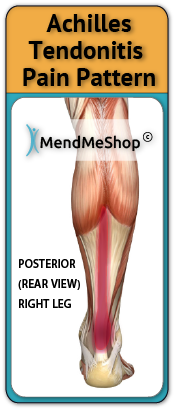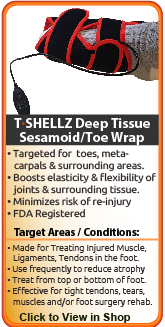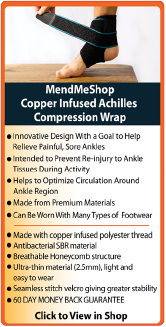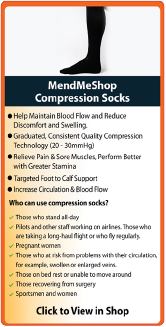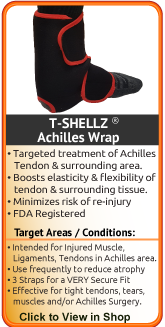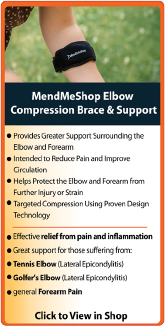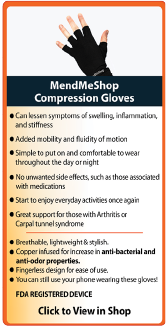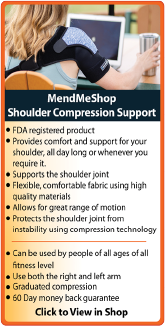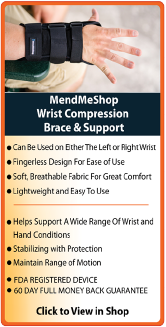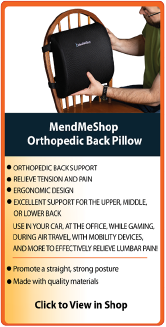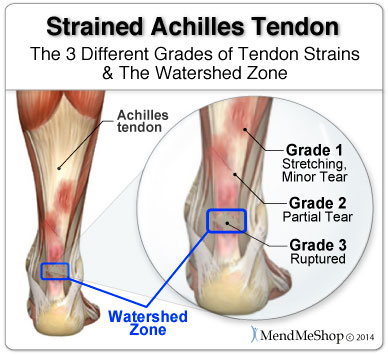What is Posterior Tibial Tendonitis
When You Roll Your Ankle and the Pain is on the Outside of the Foot, You Have Most Likely Strained the Peroneal Tendons You might be suffering from a Posterior Tibial Tendon Injury if you have:
- Pain on the inside of your foot (medial) centered around the in-step area.
- Inflammation on the inside of your foot (medial) centered around the in-step area.
- Decreased Arch Height, as this tendon assists in holding the arch of the foot upward.
- Weakness when rotating your foot inward (inversion) as this tendon prevents your foot from rolling.
- Foot Instability.
- Increased Arch Height.
Posterior Tibial Tendonitis - aka Tendinitis of the Foot
Tendinitis can affect four different tendons of the foot - the achilles tendon, posterior tibial tendon, the anterior tibial tendon and the peroneal tendon.
If a person has tendonitis of the foot, he or she may have inflammation at the in-step area of the foot and also have a flat foot deformity. The inflammation can be caused by irritation and tiny tears in the posterior tibial tendon over time (referred to as chronic tendonitis) or due to an immediate traumatic strain or tear (referred to as acute tendonitis).
Symptoms of Posterior Tibial Tendonitis
Symptoms of an inflamed posterior tibial tendon may include:
- Pain along the in-step of the foot.
- Shooting, stabbing or burning pain in the foot.
- If standing on their toes, the patient will feel intense pain in the arch of their foot.
A Posterior Tibial tendon injury is usually caused by repetitive use of the tendons, but can also be caused by trauma such as a rolled or sprained ankle. Little tears in the tendon irritate the tendon fibers resulting in pain and inflammation, resulting in an inability to maintain strength along the tendon.
Posterior Tibial tenosynovitis is swelling and inflammation of the tendons' sheath (or covering) which prevents the tendons from gliding smoothly within the sheaths, causing pain. It can be experienced at the same time of posterior tibial tendonitis, and has similar symptoms. It often results in trouble moving the ankle and will feel sore to the touch. In rare cases, tenosynovitis can be caused by infection, so it is always recommended to check with your doctor to rule this out as a cause.
Tearing of a posterior tibial tendon is not uncommon. This leads to pain, swelling, sensitivity and a sense of instability in the ankle. The tendon(s) can also pop out of the supporting ligaments that hold them in place; this is known as a tendon dislocation.
Who is at High Risk of Posterior Tibial Tendonitis?
- People who play sports or do activates that involve repetitive ankle movements.
- People who participate in activities such as running on uneven surfaces, racket sports, basketball, hiking, or skiing.
- People who wear ill-fitting shoes or shoes that cause foot instability, as these shoes will increase the risk of an inward rolled ankle
- People in aging populations, because our tendons lose elasticity and become brittle.
Causes of Posterior Tibial Tendonitis
Peroneal tendonitis is the degeneration of the tendon tissue in the ankle. What causes our tendon to start to fall apart?
- Poor footwear encouraging your foot to roll inward stretching the tendons.
- Improper training to an exercise program you have just started
- Repetitive ankle motions in sports, such as running and jumping
- A blow to the inside of the ankle or an ankle sprain
- A flat foot puts extra tension on the posterior tibial tendons. Chronic flat foot syndrome may mean your posterior tibial tendons have lengthened permanently.
- Incorrect alignment of heel and foot bones
- A build up of scar tissue on the tendon, the weakened area of the tendon may tear or lead to rupture
Posterior Tibial Tendon Dislocation (subluxation) / Tearing or dislocation can happen in 1 or both of these tendons. This leads to pain, swelling, sensitivity and a sense of instability behind the outside of the ankle. They can also pop out of the supporting ligaments that hold them in place (a dislocation). After this happens you might repeatedly dislocate the tendons in your ankle and this tissue will tear even more without proper treatment. If you suffer from torn (ruptured) or dislocated peroneal tendons you might need stitches or even a tendon replacement to fix the problem.
Posterior Tibial Tendonitis Diagnosis
The diagnosis of posterior tibial tendonitis is usually made by examination of the ankle. A physical check by your doctor will help to determine where the tendons are inflamed, ruptured, or degenerated. The doctor will move your ankle into different positions during a physical examination. These tendons are usually checked by using the single foot raise.
Single Foot Raise
The patient is asked to stand with full weight on the afflicted foot with the other foot in the air. At this point the patient is asked to raise up on their toes. If the tendon is attenuated or ruptured, the patient will be unable to do so. In cases of tendonitis or tendinosis, the patient may be able to do so but it will be painful.
X-rays may be ordered to make sure there is no fracture or other problem with your fibula or the other bones in your ankle. Your doctor may order a magnetic resonance imaging (MRI) scan of your ankle. These images can show if there is abnormal swelling or scar tissue in the tendons. MRI scans can also show lengthwise tears in the tendons.
Scar Tissue - A Big Problem with Tibial Tendinosis & Tenosynovitis
As we mentioned before, the body's natural way to repair tendon tears is to grow massive amounts of scar tissue. This is tough, dense, brittle tissue that isn't nearly as flexible as healthy tendon tissue. It's only meant as a band-aid solution to bring the edges of your tear together and prevent further damage to your tissue. Unfortunately scar tissue will grow in any direction and won't grow straight / flat like normal healthy tissue. This unorganized growth of scar tissue is ultimately what causes stiffening in your ankle, nerve entrapment, restriction of movement, less elasticity, poor circulation, and reduced flexibility of ankle tissue.
 It's important to rest the torn tendon because our natural healing process takes time to heal completely. If you don't rest your torn tendon, your acute tendonitis can quickly turn into a chronic tendonitis injury. To repair our damaged tendon tissue quickly, our bodies will use scar tissue to fill in the tears in the tendon. If you need to rest for an extended period of time and avoid certain activities that make your pain worse, you'll be more likely to develop massive amounts of this scar tissue as a temporary healing measure.
Scar tissue may plague you for weeks, months and maybe even years, depending on your level of activity and the amount of conservative treatments you have done during your rehabilitation. Scar tissue is a major problem, especially when it comes to re-injury of your tendon. When dealing with scar tissue it's always important to:
- listen well to your physician, and remember to stick to your conservative treatment plan. Using these treatments every single day will help minimize the amount of scar tissue that will grow in the wound.
- know that frequent use of a
Cold Compress or Ice Pack will help reduce the swelling very quickly. Much of the pain you feel will typically be from the swelling, and you'll be surprised how fast pain drops once the swelling is down. Scar tissue growth is further inhibited by a reduction in inflammation (swollen tissue prevents blood flow - tissue dies without blood and scar tissue grows in its place)
- know that the
TShellz Wrap will help reduce scar tissue and increase blood flow to the area (thereby accelerating the body's own healing process). Do not use if there is a lot of swelling, use a Cold Compress or Ice Pack instead.
- use the
TShellz Wrap before physical activity or stretching.
Heat emitted from the TShellz Wrap will help the connective tissue in your joint elongate, and stay elongated for some time after treatment. It will also temporarily increase the flexibility of soft tissue, meaning that it helps improve range of motion while simultaneously reducing your risk of re-injury which is exactly what you want when trying to recover from soft tissue injuries.
- stretching, as assigned by your PT or doctor can not only help get rid of scar tissue, but also promote growth of healthy, flexible tissue.
Nonsurgical Treatment for Posterior Tibial Tendonitis
If you have a lot of pain you may need to have a walking boot or cast for 2 to 4 weeks. If there is no pain or tenderness with walking a stirrup ankle brace, arch support, or lateral heel wedge can help to take tension off of your injured tendons.
In most cases, your Doctor will start with non-surgical treatments options. Some of the options your doctor may recommend include drugs or medications like NSAIDs (non-steroidal anti-inflammatory drugs) to manage pain and inflammation. Steroid injections are advised with caution for any type of tendon condition as there is increased risk of tendon rupture.
(reference: American Academy of Orthopaedic Surgeons)
Restricted Movement Is Risky If It Goes On For Too Long
For acute (new or recent) Achilles tendon tears that have the ability to heal on their own - your doctor may even cast your foot in a toe pointed position (in something called a "hanging enquinus cast") or in a removable brace/splint. A removable splint can be very helpful to prepare you for PT sessions and mobility exercises.
Prolonged use of a cast, removable splint, or long-term rest (restricted movement) without proper exercise or stretching can make your Achilles tendon injury worse. If your Achilles tendon remains completely immobilized and at constant rest, the ends of the Achilles tendon (where it attaches to bone or other muscles) will begin to fill in with scar tissue as part of the healing process. You may also have on-going symptoms of pain, swelling and inflammation, and even poor blood flow circulation.
Lack of proper blood flow and growth of scar tissue will decrease the natural length of the tendon (atrophy) and tighten tissue, reducing the flexibility between your ankle and foot. Your ability to push off with your foot in certain activities such as running, jumping, or going up and down stairs all become compromised. You are also at an increased risk of re-rupture of the tendon, especially if the initial injury was large and required surgery in the first place.
Peroneal Tendonitis Home Conservative Treatment Options
Step 1 - Reduce Pain and Swelling with Cold Compression
The first step for conservative treatment of your foot tendonitis is to reduce the swelling to "open up" the area for more blood flow. Anyone in the health-care business knows that your blood supplies the oxygen and much needed nutrients required to heal foot tendonitis injuries. This is why for years, doctors, trainers, and other medical professionals have recommended RICE (Rest, Ice, Compression, Elevation) to treat the pain and swelling of fresh injuries, chronic pain, and after any re-injury.
This is important because once blood vessels are blocked or damaged, they can no longer carry oxygenated blood to your damaged tendon and tissues begin to break-down. Without cold compression, tissues break down further because they can't get the oxygen they need to survive. By limiting the amount of damage done to your tendons, you also limit the amount of healing that needs to occur. This is a very important step to heal acute or chronic tendon injuries faster and with less pain!
Use a Cold Compress or Ice Pack:
- 24 to 72 hours after your initial tendon injury or when you first notice pain and swelling in your foot to stop tissue damage at the microscopic level, relieve pain, and decrease swelling.
- After exercise, workouts or activity of any kind to prevent re-injury of your foot tendonitis.
- Before and after surgery during rehabilitation to control pre and post-surgery pain and swelling.
- Anytime you feel your foot has been over-extended, over-worked, twisted, strained or sprained causing pain and swelling.
- Anytime you have swelling, sharp throbbing pain or inflammation in the tendons in your foot.
- Any other situation where you need to draw the pain and inflammation out of your foot.
Step 2 - Improve Circulation, Soften Scar Tissue & Prevent Re-Injury with a TShellz Wrap®
Once the swelling is gone, moving the tendon and applying a local circulatory stimulation device like the TShellz Wrap® is really what is needed for completing the recovery cycle. This is critical because tendons are known to receive very little natural blood flow and blood flow is really how your body is able to heal itself. When the tendon tissue is damaged, the already-reduced blood flow is decreased down to a trickle which is why movement is encouraged - it helps get blood flow to where it is needed.
Blood flow (healthy circulation) is an important part of natural tissue healing. Injured tendons take the nutrients available in local blood flow (like oxygen and healing agents) to get rid of any damaged tissue and start growing healthy tissue.
Sometimes Tendons Can't Receive
Enough Natural Blood Flow for Healing
In some cases of acute tendonitis, the micro-tearing is located in an area known as the watershed zone.
The watershed zone is basically a part of the tendon that has the weakest amount of blood supply (even when it's completely healthy with no tears). This area usually gets blood supply from peripheral veins. This reduced blood supply makes the watershed zone an area of your tendon that's prone to injury and a poor healing response.
Many tendons in the body are known to have watershed zones that are prone to tendon tears. Some of the tendons that have a watershed zone include the Achilles tendon, the posterior tibial tendon in the foot / ankle, the rotator cuff (supraspinatus) tendon in your shoulder, the bicep and tricep tendons in your arm and the flexor tendons in your hand.
Increased Blood Circulation = Increased Healing Capability
TShellz Wraps® contain a unique Carbon Fiber Energy Pad which is flexible and will shape to conform to your body. This Energy Pad emits a uniform wave of perfectly safe energy over its entire surface. This energy is absorbed by soft tissue in the treatment area, opening blood vessels, resulting in an increase in blood flow. Increased blood circulation is what your body needs to accelerate the healing of soft tissue and this is why we recommend the TShellz Wrap®.
The TShellz Wrap® is an FDA Registered Medical Device and is suitable for use in therapeutic clinics and FROM HOME. It is completely safe for people and patients to use for themselves.
The technology found in a TShellz Wrap® has been used for decades in the worlds of professional and amateur sports - a contributing factor as to why athletes seem to recover from injuries so quickly.
Have you ever wondered by an athlete can return to activity after 3 or 4 weeks following a tendon injury - while your average person takes much longer to return back to normal? The secret isn't really that much of a secret - it involves consistent treatments (meaning multiple times a day) using a treatment like the TShellz Wrap® to stimulate blood flow to the injured tissues. Most athletes have the luxury of using in-house facilities many times per day.
How many us can afford the time and money to visit a clinic multiple times a day? Very few indeed. This is how you can gain some of the advantages that athletes enjoy in their injury recovery - by using a device like the TShellz Wrap® two or three times a day on a consistent basis.
Consistent Treatments = Consistent And Long Term Improvement
What Else Makes the TShellz Wrap® So Special?
We believe the TShellz Wrap® to be one of the most effective home treatments to increase localized blood flow in and around the treatment area.
We can promise that you will receive a product that is designed to be safe and does what it is supposed to do...quickly relieve pain and aid in the recovery from tendon, muscle and other soft tissue injuries.
The unit plugs into a standard wall outlet to get its power. The nice thing about the power supply is that the same unit can be used in North America and overseas as well. It has the capability to operate between 110v and 230v.
The TShellz Wrap® has a special signal controller that can be set for 3 different power levels of application (3=High, 2=Medium, 1=Low). The cord is long enough that you can sit or lie comfortably and watch TV, read or surf the net while you're using it.
Treatments are max 30 minutes in duration and the device can be worn over clothing. This allows you to use the device at work, at home, or really anywhere you have access to an electrical outlet.
A Recap of the Benefits of the TShellz Wrap®..
- Targeted applications for most areas of the body
- It can be used before exercise to warm up tissue in the treatment area to reduce the risk of injury
- FDA Registered medical device for use in home or clinics - very high quality
- Increases flexibility of tissues (reducing the re-injury factor)
- It soothes pain and whisks away toxins
- Carbon fiber Energy Pad is strong, lightweight, and flexible - contours very easily
- Enhanced blood flow provides an accelerated healing rate that will save time and money when associated with doctor or physical therapist visits
- A boost in blood flow will maximize the bodys ability to recover quickly. This can be beneficial in post-surgery rehabilitation, getting you back to work faster. Do not use until at least 6 weeks after surgery, and only after approval from your doctor.
When Should I Use My TShellz Wrap® During the Day?
The most common question we receive from individuals prior to purchasing is - how many times a day should I be using my wrap and when should I be using them? While treatment plans will differ for each individual and their specific injury, there are general guidelines that should be adhered to.
- Use a Cold Compress or Ice Pack when you are experiencing inflammation (usually after exertion or movement of the injury area).
The TShellz Wrap® would then be used:
- Right after rising from bed in the morning (as this is when it is most stiff)
- Prior to going to bed at night (to relax the area and allow for better sleep)
- Before you know you will be using your injured joint (going to work, driving, typing, etc).
Step 3 - Stretch Your Foot to Speed Up Recovery
The final step in foot tendonitis recovery is stretching - this is a critical step for complete recovery from your injury! PTs almost always prescribe gentle stretching for to deal with foot tendonitis. Outside of the PT office, you will likely be assigned a set of stretches and exercise to do at home.
You'll find in most rehabilitation programs stretches combined with other conservative treatments will help to:
- build muscle strength in your lower leg (calf muscle)
- increase mobility and range of motion (ROM)
- speed overall healing of your foot tendonitis
- prevent muscle loss (atrophy) in your lower leg
- improve muscular function and capability
- refine tendon tissue alignment and physical balance
- encourage overall foot and ankle joint flexibility
- facilitate proper warm up for regular exercise
- promote healthy circulation in your foot
Prevention
Preventive measures for all types of foot tendinitis include, proper warm up and stretching exercises, wearing the right shoe for the activity, choosing shoes with good arch and heel support and varying your exercise route and routine. (This will help keep one set of muscles from being overstressed).
Gentle stretching is important to help align scar tissue along the normal lines of stress and strength in the healing tendon is enhanced. Scar tissue is fibrous and brittle, without the correct alignment you're left with a weak ankle. You'll have pain and tightness in your ankle for even the smallest daily activities, an this will greatly increase your chance of re-injury.
Product Advisors are available 9:00 am to 5:00 pm Eastern Standard Time Monday to Friday.
Learn More About Tendon Injuries & TreatmentsI want to learn more about Post-Surgery Recovery I want to learn more about TShellz Wrap® Circulatory Boost I want to learn more about Ice & Heat: Which Is Better For Treatment? I want to learn more about Tendonitis Treatments I want to learn more about Tendonitis Surgery
FREE SHIPPING ON ALL PRODUCTS CURRENTLY ENABLED
60 DAY TRIAL PERIOD
During your recovery, you will probably have to modify and/or eliminate any activities that cause pain or discomfort at the location of your soft tissue injury until the pain and inflammation settle. The more diligent you are with your treatment and rehabilitation, the faster you will see successful results!
| 

